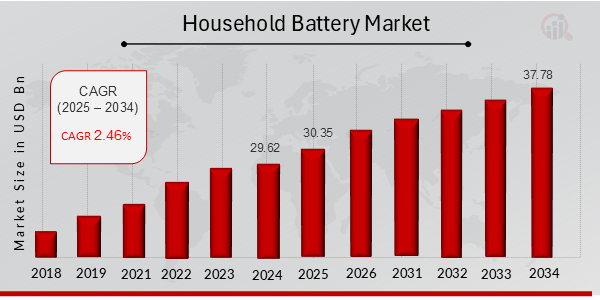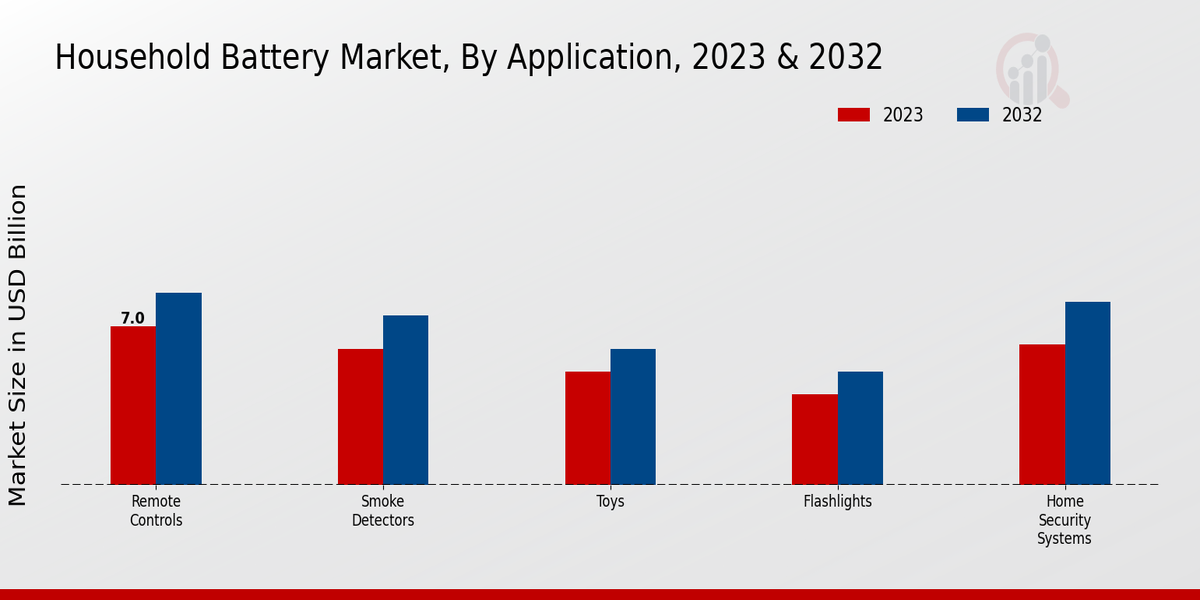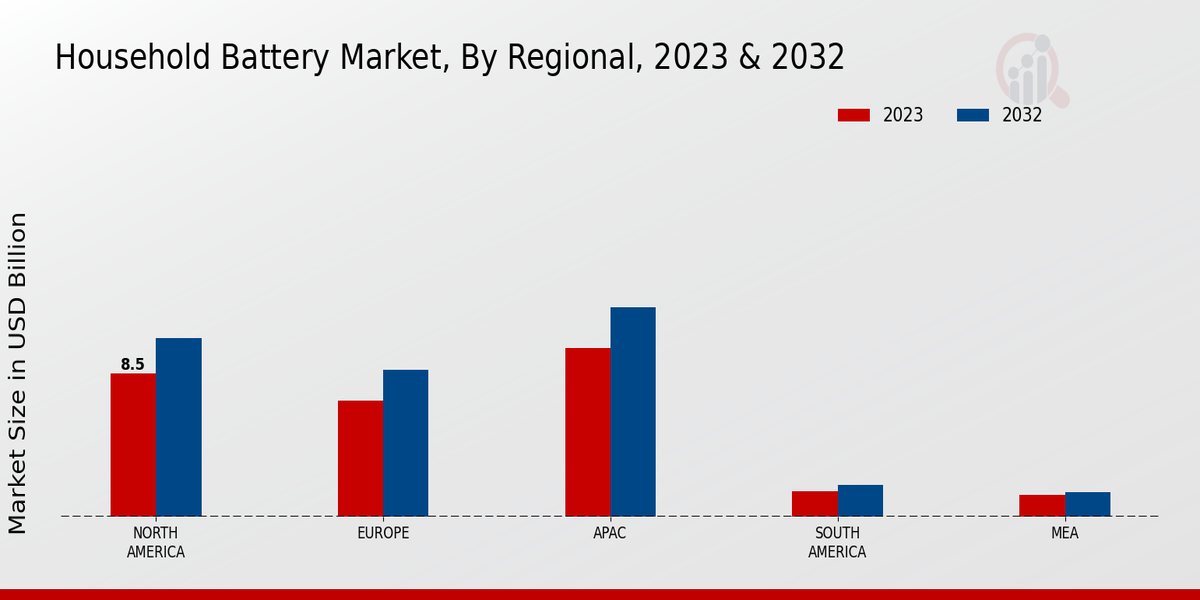Global Household Battery Market Overview
As per MRFR analysis, the Household Battery Market Size was estimated at 29.62 (USD Billion) in 2024. The Household Battery Market Industry is expected to grow from 30.35 (USD Billion) in 2025 to 37.78 (USD Billion) till 2034, at a CAGR (growth rate) is expected to be around 2.46% during the forecast period (2025 - 2034).
Key Household Battery Market Trends Highlighted
The Household Battery Market is experiencing significant growth driven by increasing demand for portable electronic devices like smartphones, laptops, and smart home products. Environmentally friendly battery technologies are gaining traction as consumers and manufacturers alike focus on sustainability. This shift is fueled by regulations aimed at reducing carbon footprints alongside the growing prevalence of electric vehicles, which also rely on advanced battery technologies. Additionally, the rise in renewable energy sources such as solar power contributes to the market's expansion, as batteries serve as essential components in energy storage systems, enabling households to maximize their energy usage.There are abundant opportunities to be explored in the area of battery recycling and reuse. Companies can capture market share by developing efficient recycling programs that extract valuable materials from spent batteries, thus promoting a circular economy. The demand for longer-lasting and faster-charging batteries continues to grow, providing a platform for innovation in battery chemistry and design. Advancements in solid-state battery technology and the integration of artificial intelligence for smart energy management also present promising areas for development, appealing to environmentally conscious consumers seeking more efficient solutions.Recent trends indicate a shift towards lithium-ion and alkaline batteries, with manufacturers focusing on enhancing energy density and safety features. The market is also witnessing a rise in consumer interest in smart batteries that can communicate usage data and performance metrics.
Moreover, the integration of Internet of Things (IoT) technology into household devices drives the need for batteries that can support continuous connectivity and energy-efficient operations. These evolving consumer preferences shape product innovation and influence global supply chains, reinforcing the importance of adaptability within the industry.

Source: Primary Research, Secondary Research, MRFR Database and Analyst Review
Household Battery Market Drivers
Increasing Demand for Portable Energy Solutions
The Household Battery Market Industry is experiencing significant growth due to the increasing demand for portable energy solutions. As more people rely on portable electronic devices like smartphones, tablets, laptops, and smart home devices, the need for efficient and reliable power sources becomes paramount. The rise in the adoption of wireless technology and electronics in everyday life has driven consumers to seek high-performance batteries that can provide longer life spans and faster charging capabilities.This trend is reinforced by the growing preference for environmentally friendly battery solutions as consumers become more eco-conscious. Manufacturers are responding to this demand by innovating and improving battery technology, making household batteries more efficient. As the trend of remote work and mobile lifestyles continues to thrive, it is expected that the demand for household batteries will escalate in the coming years. Companies are also exploring new materials, such as lithium-ion and other advanced battery compositions, which offer higher energy densities and support a wider range of applications.Furthermore, the integration of smart technology in household batteries is fueling growth, as consumers appreciate the functionality of systems that can monitor battery health, optimize usage, and provide alerts for maintenance. As the market continues to evolve, we can expect to see more products that align with the changing consumer expectations, thereby propelling the Household Battery Market Industry forward.
Growth of Smart Home Devices
The rise of smart home devices is a significant driver of the Household Battery Market Industry. The increasing integration of smart technology into homes, such as smart thermostats, security systems, and voice-activated assistants, requires a reliable power source. Consumers are increasingly opting for battery-operated appliances that provide convenience and efficiency. As this trend grows, manufacturers are motivated to develop batteries optimized for longer life and effectiveness in smart applications.
Advancements in Battery Technology
Technological advancements in battery technology are driving the Household Battery Market Industry. Innovations like lithium-ion batteries, rechargeable power sources, and enhanced energy storage solutions are making household batteries more efficient and durable. The focus on research and development to create longer-lasting, faster-charging batteries is also influencing consumer preferences, resulting in an increased uptake of high-performance battery products in households.
Household Battery Market Segment Insights
Household Battery Market Application Insights
The Household Battery Market, valued at 28.21 USD Billion in 2023, is characterized by diverse applications that span various segments. Among these applications, Remote Controls held a significant market share, generating a value of 7.0 USD Billion in 2023, with a growth forecast to reach 8.5 USD Billion by 2032. This dominance can be attributed to the proliferation of smart home devices and electronic appliances that require reliable battery power. Similarly, the application of Smoke Detectors is vital for home safety, with a market value of 6.0 USD Billion in 2023, expected to grow to 7.5 USD Billion by 2032.The increasing awareness around fire safety enhancements drives consistent demand in this sector. The Toys segment also plays a crucial role, valued at 5.0 USD Billion in 2023 and projected to advance to 6.0 USD Billion, supported by the rising popularity of battery-operated toys and educational gadgets for children.
Flashlights, valued at 4.0 USD Billion in 2023 and expected to grow to 5.0 USD Billion, remain essential for home and outdoor utility, particularly in regions prone to power outages or during emergencies. Finally, Home Security Systems, valued at 6.21 USD Billion in 2023 and forecasted to grow to 8.1 USD Billion, reflects the increasing investments consumers make in enhancing home security, significantly contributing to the market growth.Overall, the Application segment demonstrates diverse areas of demand, with Remote Controls and Home Security Systems leading in their respective growth, indicating not just the necessity of household batteries but also the shift toward smart and secure living environments. The evolution in consumer preferences towards enhanced safety measures and technological advancements within homes is set to continually influence the Household Battery Market revenue through these applications. This segmentation shows how various household applications leverage battery technology, ultimately contributing to the Household Battery Market statistics and illustrating its importance in everyday life.

Source: Primary Research, Secondary Research, MRFR Database and Analyst Review
Household Battery Market Battery Chemistry Insights
The Household Battery Market revenue is projected to reach 28.21 billion USD in 2023, reflecting a progressive growth trajectory within the Battery Chemistry segment. Diverse chemical formulations, including Alkaline, Lithium-ion, NiMH, Lead-acid, and Zinc-carbon, each catering to specific consumer needs, characterize this market. Alkaline batteries are widely recognized for their long shelf life and reliability, often dominating the market due to their extensive application in household devices. Lithium-ion batteries have gained significant traction, particularly because of their rechargeable features and efficiency, making them crucial for modern electronics.NiMH batteries, known for their environmental benefits and performance in rechargeable formats, also hold a noteworthy position. Meanwhile, Lead-acid batteries are primarily utilized in larger applications like UPS and backup systems, showcasing versatility in various households. Zinc-carbon batteries, although older technology, continue to serve in low-drain devices. The diverse Household Battery Market segmentation indicates evolving consumer demands and technological advancements driving innovations in energy solutions, presenting both challenges and opportunities for market players.Market statistics reflect the ongoing need for sustainable and efficient battery solutions, assisting a more comprehensive understanding of consumer preferences and requirements.
Household Battery Market Form Factor Insights
The Household Battery Market, valued at 28.21 USD Billion in 2023, showcases a diverse range of form factors, reflecting its extensive application across various consumer needs. Among the numerous types, AA and AAA batteries hold a significant position, widely utilized in everyday devices like remote controls and toys, contributing notably to the market's volume. Button cells are essential for powering small electronics such as watches and hearing aids, underlining their critical role in the market. C and D batteries, often employed in larger devices such as flashlights and toys, dominate segments requiring higher energy capacities.Overall, form factor segmentation plays a crucial role in the Household Battery Market revenue, with each type catering to specific user requirements. The rising demand for portable electronic devices and advancements in battery technology support the market growth. However, challenges like environmental concerns regarding battery disposal and recycling efforts persist. Despite these hurdles, opportunities for growth in renewable energy applications and smart home technologies are emerging, driving innovation in the industry.As the Household Battery Market statistics suggest, understanding these form factors is vital for stakeholders aiming to navigate the evolving landscape effectively.
Household Battery Market End-Use Insights
The Household Battery Market has shown considerable growth in various End-use segments, particularly Residential, Commercial, and Industrial applications. In 2023, the Household Battery Market revenue reached approximately 28.21 USD Billion, reflecting the dynamic nature of the industry.
The Residential segment plays a crucial role, as consumers increasingly rely on batteries for power storage and backup solutions in everyday home devices. The Commercial segment is equally vital, driven by the growing demand for efficient power management solutions in businesses and offices, where uninterrupted power supply is essential for operational efficiency.Meanwhile, the Industrial segment dominates due to its adoption of large-scale battery systems for energy storage and manufacturing processes, aligning with sustainability trends and the transition to renewable energy sources. As the preference for sustainable energy solutions grows, the market will continue evolving, revealing new opportunities and challenges, thereby driving the Household Battery Market statistics. This segmentation provides insight into the diverse applications and growing demand in the energy-storage landscape, shaping the future of the industry.
Household Battery Market Regional Insights
Diverse regional dynamics characterize the Household Battery Market. In 2023, North America held a significant valuation of 8.5 USD Billion, projected to reach 10.55 USD Billion by 2032, demonstrating its major influence in the market. The European market followed closely with a valuation of 6.9 USD Billion in 2023, expected to grow to 8.7 USD Billion, reflecting its substantial demand for household batteries. The APAC region dominates the market with a valuation of 10.0 USD Billion in 2023, forecasted to rise to 12.4 USD Billion, underscoring its vast consumer base and technological advancements.In contrast, South America and MEA are relatively smaller segments, valued at 1.5 USD Billion and 1.31 USD Billion, respectively, in 2023, with slight increases anticipated by 2032. These figures highlight the varying market growth prospects across regions, where North America and APAC emerge as major players due to their high consumption rates and innovation in battery technology. Overall, the Household Battery Market segmentation reveals significant opportunities and growth drivers, particularly in regions that prioritize energy efficiency and sustainability.

Source: Primary Research, Secondary Research, MRFR Database and Analyst Review
Household Battery Market Key Players and Competitive Insights
The Household Battery Market is characterized by rapid innovation and fierce competition as manufacturers strive to capture consumer attention and maintain market share. This sector has been significantly influenced by the increasing demand for portable energy solutions, driven by the proliferation of electronic devices in households. Companies are investing in research and development to produce batteries that are not only efficient and long-lasting but also environmentally friendly. Factors such as sustainability, cost-effectiveness, and the advent of rechargeable options have reshaped the competitive landscape, allowing companies to differentiate themselves in a crowded market. The competitive dynamics are further amplified by changing consumer preferences and regulatory pressures, compelling brands to adapt their strategies accordingly to remain relevant.Maxell has carved out a notable presence in the Household Battery Market, renowned for its innovation and quality. The company has established a reputation for producing a diverse range of battery types, from alkaline to rechargeable variants, catering to both everyday consumers and specialized applications. Maxell's strengths lie in its commitment to product reliability, advanced technology, and sustainability practices, which resonate well with current consumer trends favoring eco-friendly products. Furthermore, the brand's strategic marketing efforts and partnerships have enhanced its visibility in the market, ensuring that Maxell remains a formidable competitor. The company's focus on R&D has led to the development of products that meet the emerging needs of consumers, thus solidifying its standing in the household battery sector.Duracell is another key player in the Household Battery Market, recognized for its strong brand equity and extensive product portfolio. The company has long been synonymous with durability and performance, positioning itself as a trusted household name. Duracell's strengths are rooted in its robust manufacturing capabilities and continuous innovation, particularly in the alkaline battery segment, where it has maintained a leadership position. The brand's investment in marketing and consumer engagement has fostered deep brand loyalty, making Duracell a preferred choice among consumers seeking dependable power solutions.
Additionally, Duracell's focus on leveraging its global distribution network facilitates its reach into various markets, allowing it to adapt products to meet localized demand. The company's commitment to sustainability, through initiatives such as recycling programs, further enhances its competitive advantage and aligns with the growing consumer demand for environmentally friendly options.
Key Companies in the Household Battery Market Include
- Maxell
- Duracell
- EVE Energy
- Samsung SDI
- Energizer
- Guangzhou CBAK Energy Technology
- Panasonic
- Sanyo
- Varta
- Sony
- LG Chem
- BYD
- Rayovac
- Toshiba
- A123 Systems
Household Battery Market Industry Developments
Significant advancements and corporate activities have marked recent developments in the Household Battery Market. Companies such as Samsung SDI and LG Chem are expanding their battery production capabilities to cater to rising consumer demands, particularly for energy-efficient solutions. Maxell and Panasonic are also enhancing their product lines with improved lithium-ion technologies to compete in the growing market. The competitive landscape saw Duracell and Energizer strengthen their market presence through innovative marketing strategies aimed at increasing brand loyalty. Notably, EVE Energy and Guangzhou CBAK Energy Technology are making strides in developing eco-friendly battery options to address environmental concerns.
Additionally, Varta has announced partnerships with tech companies to integrate advanced battery technologies into smart home devices. Merger and acquisition activities are being observed as well, with companies like A123 Systems potentially seeking partnerships to boost their market positions. The market valuation of these companies continues to grow, driven by an increasing need for sustainable and high-performance battery solutions, directly impacting consumer adoption and innovation in household battery technologies.
- Household Battery Market Segmentation Insights
- Household Battery Market Application Outlook
- Remote Controls
- Smoke Detectors
- Toys
- Flashlights
- Home Security Systems
- Household Battery Market Battery Chemistry Outlook
- Alkaline
- Lithium-ion
- NiMH
- Lead-acid
- Zinc-carbon
- Household Battery Market Form Factor Outlook
- Button Cells
- AA Batteries
- AAA Batteries
- C Batteries
- D Batteries
- Household Battery Market End-Use Outlook
- Residential
- Commercial
- Industrial
| Report Attribute/Metric |
Details |
|
Market Size 2024
|
29.62 (USD Billion)
|
|
Market Size 2025
|
30.35 (USD Billion)
|
|
Market Size 2034
|
37.78 (USD Billion)
|
|
Compound Annual Growth Rate (CAGR)
|
2.46% (2025 - 2034)
|
|
Report Coverage
|
Revenue Forecast, Competitive Landscape, Growth Factors, and Trends
|
|
Base Year
|
2024
|
|
Market Forecast Period
|
2025 - 2034
|
|
Historical Data
|
2019 - 2023
|
| Market Forecast Units |
USD Billion |
| Key Companies Profiled |
Maxell, Duracell, EVE Energy, Samsung SDI, Energizer, Guangzhou CBAK Energy Technology, Panasonic, Sanyo, Varta, Sony, LG Chem, BYD, Rayovac, Toshiba, A123 Systems |
| Segments Covered |
Application, Battery Chemistry, Form Factor, End Use, Regional |
| Key Market Opportunities |
Rising demand for renewable energy, Growth in smart home devices, Increase in electric vehicle adoption, Expansion of portable electronic devices, and Shift towards eco-friendly batteries. |
| Key Market Dynamics |
growing consumer electronics demand, increasing renewable energy adoption, environmental regulations on battery disposal, advancements in battery technology, competitive pricing pressure |
| Countries Covered |
North America, Europe, APAC, South America, MEA |
Frequently Asked Questions (FAQ) :
The Household Battery Market is expected to be valued at 37.78 billion USD in 2034.
The expected CAGR for the Household Battery Market from 2025 to 2034 is 2.46%.
The APAC region is projected to have the largest market share, valued at 12.4 billion USD by 2032.
The North American market for household batteries is expected to grow to 10.55 billion USD by 2032.
The market for household batteries in Remote Controls is projected to reach 8.5 billion USD in 2032.
The market for Smoke Detectors is expected to grow to 7.5 billion USD by 2032.
Major players in the market include Maxell, Duracell, EVE Energy, Samsung SDI, and Panasonic.
The market for household batteries in Toys is expected to reach 6.0 billion USD by 2032.
The market for household batteries in Flashlights is projected to be valued at 5.0 billion USD by 2032.
The market for household batteries in Home Security Systems is expected to reach 8.1 billion USD by 2032.

















